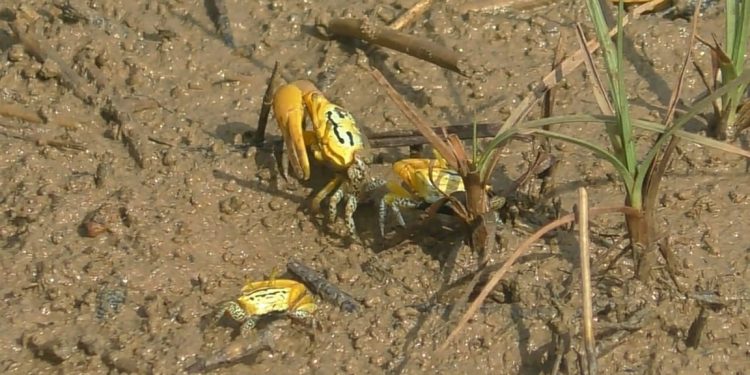Mahakalpara: The contribution of Harley Crabs to maintenance of local bio-diversity and fertility of land along with environmental balance is significant.
These marine crabs dig holes of one inch wide and 10-ft deep each in the sandy land and alluvial soil adjoining the sea beaches. These holes facilitate land aeration and allow nutrients to go inside the land raising its fertility.
These crabs prefer to make their habitats in the mangroves area and under trees and bushes on the saline lands. They feed on marine reptiles, small creatures, small fish, wastages and decomposed material that collect around their habitats or wash into these holes.
As oxygen enters these holes during stormy activities in the sea, these crabs indirectly help in the growth of mangroves and lead to a raise in the number of the wildlife creatures.
The yellow colour of their bodies and black stripes on their back make them look wonderful. The Harley Crabs live in hoards and rush inside their holes at the slightest perception of external threats.
While normal crabs have 10 legs each, these coloured crabs have nine legs. Their two main legs are relatively large and help them in gathering food and defending against enemies.
These crabs are largely seen in hordes in the vast sand beds adjoining Gahirmatha in Mahakalapara block of Kendrapara district. Lunchghola, Shola Muhana, Hukitola and Tandabaluka sea beaches are their main habitats.
However, discharge of tonnes of industrial effluents and illegal prawn gheries have jeopardized their existence leading to a steady decline in their number now.
It’s noteworthy to mention that tourists and local visitors throng these sea beaches during winter to enjoy the natural sight of these yellow Harley Crabs moving in hordes. They click selfies with these crabs.
Jackals, wild cats, stray dogs, eagles and kites eat these crabs. The rare Harley Crabs enrich the land fertility by adding nutrients to soil. They also help in maintaining the bio-diversity and ecological balance of the area.
Their mating season starts in June and July. An interesting aspect of their nature is that they could sense the arrival of natural calamities such as cyclones at least 24 hours in advance.
During such times, they leave their natural habitats and move in file to upper reaches of the land and sand before the calamities strike.
Environmentalist and convener of the conservation of marine life Samarendra Mahali says, Harley Crabs are a very old marine species and their number has been fast dwindling over recent years.
Release of massive industrial effluents and toxic chemicals , environmental imbalance, mushrooming of illegal prawn gheries in Gahirmatha restricted waters have taken a heavy toll on the life of these rare marine creatures, he added.
There is an urgent need to create local awareness to protect Harley Crabs before they go completely extinct, said local environmentalists.
PNN






































